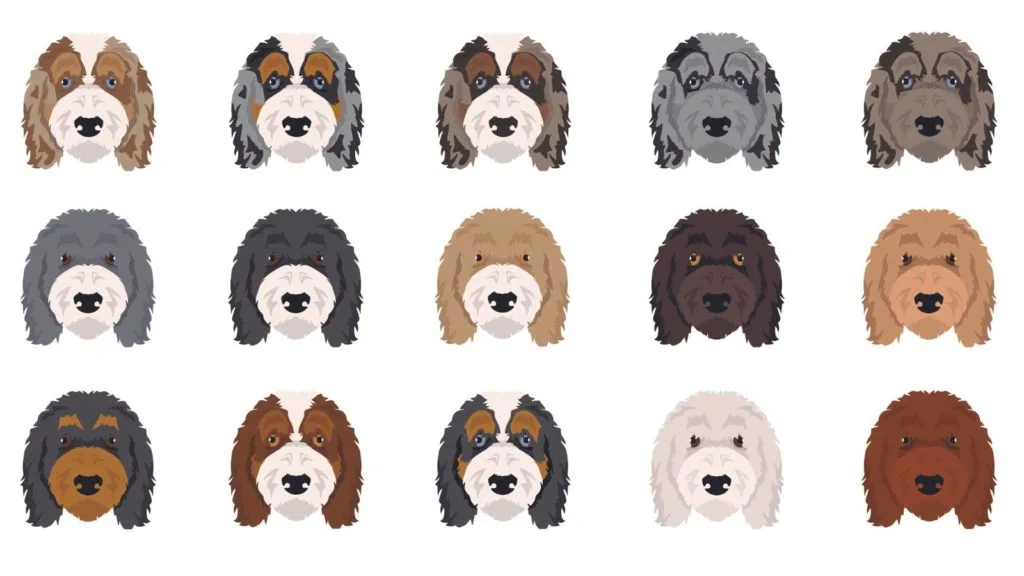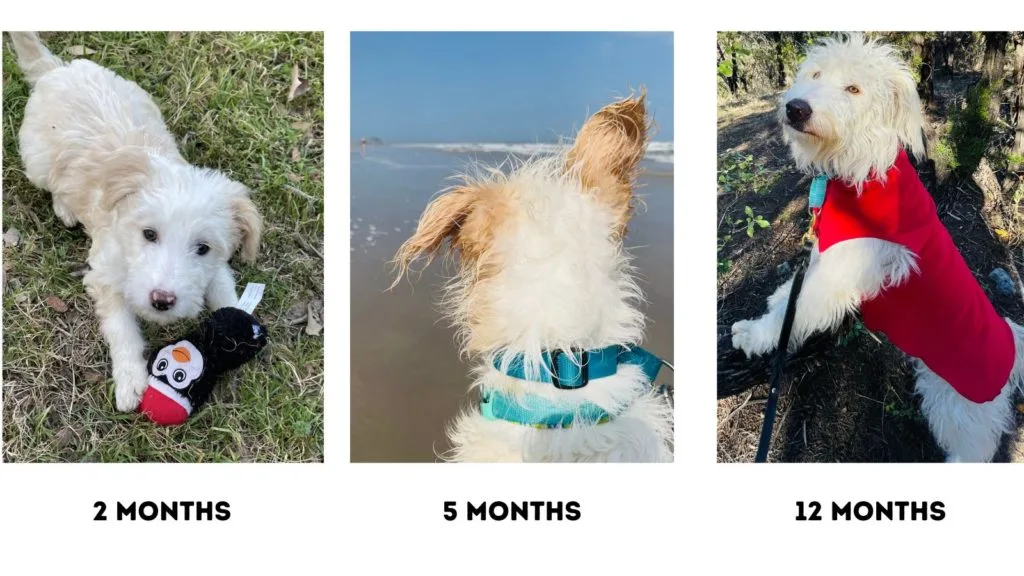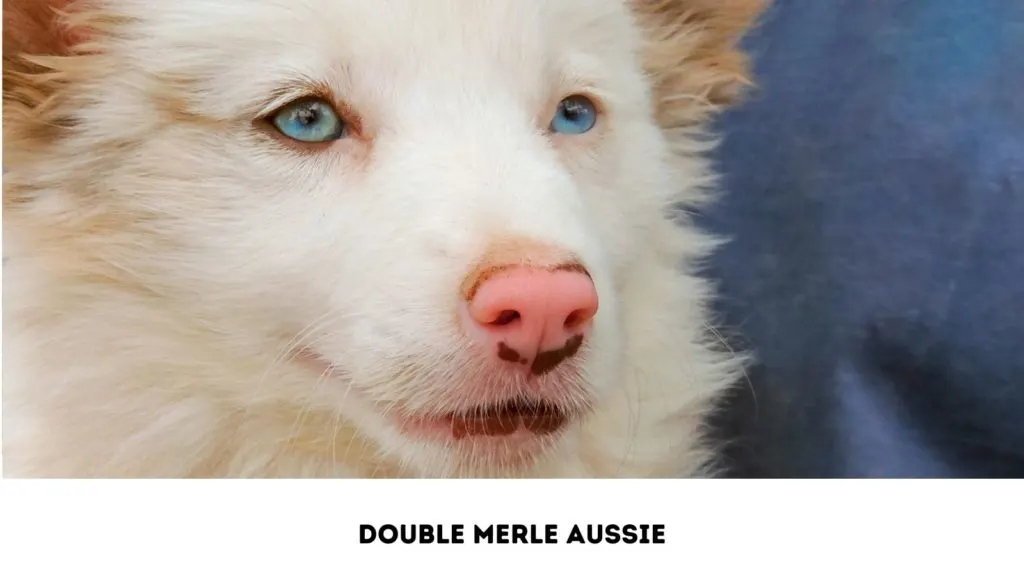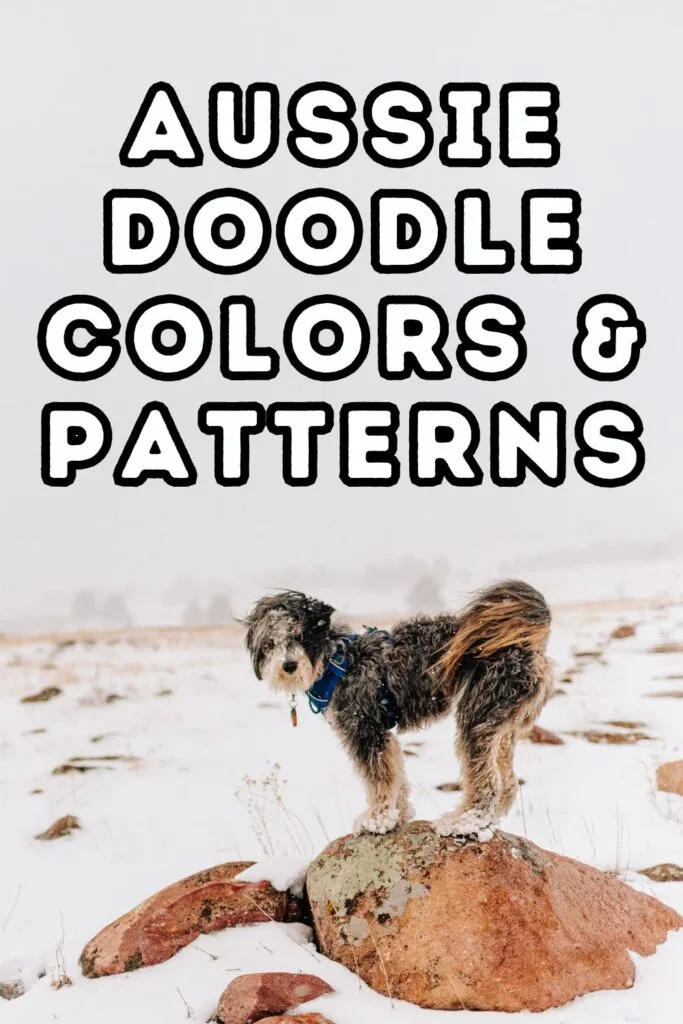More than other doodles, the colors and patterns of Aussiedoodles covers a wide spectrum thanks to the many colors of the parent breeds. Let’s look at the different Aussiedoodle colors and the potential health and behavior implications that one of these color combinations. From solid colors to combinations of colors to distinctive markings, Aussiedoodles cover a broad palette!

Photo credit: Shutterstock
Why So Many Colors?
Aussiedoodles inherit a rich palette of colors from their parent breeds. With the Australian Shepherd’s diverse color genetics, Aussiedoodles stand out as one of the few doodle breeds with a vast range of color options, even in the first generation (F1).
Colors from the Australian Shepherd Parent or Grandparent
The vibrant and patterned coats of Australian Shepherds showcase a variety of hues. Predominant colors include:
- Blue merle
- Red merle
- Solid shades of red and black
Bi-color and tri-color patterns are prevalent, featuring combinations such as black and white, or more intricate mixes involving blue or red merle.
Notably, Australian Shepherds often highlight tan or copper accents, enriching their already diverse color arrangements.
Colors from the Poodle Parent or Grandparent
Poodles stand apart with their predominantly solid-colored coats. Their color range spans:
- Black
- Blue
- Silver
- Gray
- Cream
- White
- Brown
- Red
- Apricot
Occasionally, you’ll encounter Poodles with a blend of colors, including combinations of black with brown or apricot, or even blue with white. These variations contribute to the possibility of a varied color spectrum in their Aussiedoodle offspring.

Aussiedoodle Coat Colors
Blue Merle
A true Blue Merle Aussiedoodle has a fascinating coat pattern. The base color is black, but due to the merle gene, which dilutes pigment in certain coat areas, patches of gray and sometimes white appear.
Interestingly, the merle gene can also affect eye color, leading to blue eyes or even “marble-colored” eyes with mixed hues. A Blue Merle with white chest patches is classified as “Abstract,” and any hint of brown is known as “Phantom” markings.
Brown Merle (Chocolate Merle)
Similar to Blue Merle but with a brown base, Brown Merle Aussiedoodles display a mix of dark and light brown/gray spots. These dogs often have solid-colored lower legs, indicative of Phantom markings. Their true color classification would be Brown Merle Phantom Abstract – a testament to the complex genetics at play.
Black Phantom
Black Phantom Aussiedoodles showcase distinct markings across their chest, lower legs, around the eyes and cheeks, and under the tail base. These markings can range in color from almost white to deep red.
As puppies, Black Phantoms may not show prominent Phantom markings, which tend to develop with age. It’s worth noting that the black color can fade or dilute over time, influenced by the dog’s genetics.
Brown Phantom
Much like the Black Phantom but with a brown base, the Brown Phantom Aussiedoodles also exhibit a range of Phantom coloring.
Red
Red Aussiedoodles are not as common but are strikingly beautiful. The red color can mask other patterns and markings, making genetic testing crucial, especially when breeding merle colored dogs.
Reds can vary in shade from deep red to lighter tones like cream or apricot, with the intensity of the color determined by genetic factors.
Tuxedo
Tuxedo Aussiedoodles have significant white markings that cover the entire chest, often extending to the bottoms of all four legs and around the nose.
These dogs are classified as Tuxedo if the white covers less than 50% of their body. If more than 50% is white, they fall into the “Parti” category.
Parti
Parti Aussiedoodles have over 50% of their body covered in white, regardless of the base color. This pattern often results from the combination of tuxedo or abstract markings with the parti gene.
Sable
Sable Aussiedoodles can be mistaken for fading or agouti colors. Their coat appears black-based, but the sable gene dilutes pigment, especially at the roots, giving a brownish tint as they age. Sable is a marking controlled by the same allele as phantom.
Agouti
Agouti, or “Wild Sable,” is the rarest of the colors controlled by the same allele as phantom and sable. Agouti Aussiedoodles have a unique hair pattern with alternating colors, giving a uniform appearance across their body. They can come in black or brown bases and often look more brown or red as they mature.
Brindle
Brindle Aussiedoodles have a distinct pattern that can be challenging to identify at birth but becomes more apparent as they grow. Brindles typically have stripes in their coat, which are more visible with shorter fur.
Blue Merle Phantom
This color combination includes a Black base, Merle pattern, and Phantom markings. Blue Merle Phantoms are particularly sought-after and may command higher prices.
Tri-Color
Tri-color Aussiedoodles have three colors on their coat. They can have a black base (Black Tri) or a brown base (Brown Tri). The classification can vary among breeders based on the amount of white present.
Do Aussiedoodle puppies fade or change color?
Many Aussiedoodle puppies undergo significant color changes as they grow. For example, Phantom markings become more prominent with age, but colors like black may fade to gray. Prospective owners can gauge a puppy’s potential adult coloration by looking at the parents’ coats. Breeders that do genetic testing will also know if the puppies have the fading gene.
The Poodle fading gene, scientifically known as the Progressive Graying gene or the G locus, is a genetic trait that causes coat color to lighten or fade as they age. This gene is responsible for the gradual change in coat color from a darker shade in puppyhood to a significantly lighter shade in adulthood.
If your Aussiedoodle has this gene, you may start to see their coat color change before they reach their first birthday, usually between six to ten months.
Our Aussiedoodle Isla had fawn tinted ears when we adopted her at nine weeks old. By five months they had darked some–but by a year old they were cream color!

The same happens with darker colors. An Aussiedoodle born with a rich, dark coat may gradually transition to a silver or gray color over time. Black Aussiedoodles can develop into shades of gray, silver, or blue. Similarly, Aussiepoos with brown or red coats can fade to lighter shades of cream or apricot. The rate and extent of this color change can vary greatly among individual dogs.
Monitoring your Aussiedoodle’s coat as they grow can help you anticipate and appreciate this natural change.
Impact of Coat Color on Aussiedoodle Health and Behavior
The color and pattern of your Aussiedoodle does not effect their health or behavior except in one case: the Double Merle.

A “Double Merle,” also known as a homozygous merle, is a dog who has inherited the merle gene from both its parents. This might be seen in Aussiedoodles when one parent is an Aussiedoodle and the other an Aussie or an Aussiedoodle. It can be seen in both Miniature and Standard size Aussiedoodles.
This genetic combination can lead to a predominantly white coat with some patches of color. Double merles often have light blue eyes, but they can also have brown, green, or heterochromatic eyes (eyes of two different colors), or even eyes with segments of multiple colors.
While striking in appearance, double merles often face vision and hearing loss, either complete or partial. These dogs are at a significantly higher risk of being born with hearing impairments, blindness, or other eye anomalies.
Sadly these double merle puppies were once known as “lethal whites,” not because the gene was lethal but because unscrupulous breeders would destroy the puppies.
Responsible breeders will do genetic testing on both parents (even those dogs who don’t show a merle pattern). The health challenges associated with double merles underscore the importance of ethical breeding practices, particularly when dealing with genes that have such profound impacts on a pet’s well-being.
If you find an Aussiedoodle at a shelter that is largely white, talk with the shelter about testing the dog’s hearing and vision. Look for abnormalities in the pupil as a sign of vision impairment. These abnormalities can include microphthalmia (abnormally small eyes), anophthalmia (absence of one or both eyes), colobomas (a defect in the iris) and other irregularities.
Deaf or blind double merle dogs (or deaf AND blind) can lead a full life but potential adopters should know going in that they’ll need to take extra steps in training and daily life to help their new dog meet his potential.
Frequently Asked Questions
What are the rarest Aussiedoodle colors?
Searching for an Aussiedoodle with a unique coat? Several colors and patterns are less seen than others.
Agouti or Wild Sable Aussiedoodles have a coat color where each hair strand features alternating colors, giving them a wild and varied appearance. The complexity of this coloring comes from the interaction of multiple genes, making it less commonly seen.
Brindle Aussiedoodles are also considered rare. They have a coat pattern characterized by a tiger-stripe or marbling effect. While more commonly seen in other breeds, brindle is less frequent in Aussiedoodles due to the specific genetic combinations required to produce this pattern.
Merle patterns themselves are quite common in Aussiedoodles, but unique variations like Blue Merle Phantom or Merle patterns combined with other less common markings can be rare.
Which Aussiedoodle color is the most expensive?
- Merle Patterns: Particularly Blue Merle or Chocolate Merle. The unique and visually striking appearance of merle patterns often makes them highly desirable. This can be especially true for merles with unusual or distinctive markings, or those with blue eyes. (Some breeders will charge more for Aussiepoos with blue eyes.)
- Tri-Color: Tri-color Aussiedoodles, which have a combination of three distinct colors in their coat, can also be priced higher. This is due to their appealing look and the genetic rarity of achieving this specific color combination.
- Rare Colors: Any color or pattern that is less common, such as unique variations of Phantom, Sable, or Brindle, might be priced higher due to their rarity.
- Parti or Tuxedo Patterns: These patterns, characterized by significant portions of white in the coat combined with another color, can also be quite popular and may command higher prices.
More Questions You Might Have
Are Aussiedoodles Hypoallergenic?
Pin it to remember

- What’s an Unfurnished Aussiedoodle? - December 14, 2024
- 500+ Aussiedoodle Names - July 29, 2024
- Does Your Breeder Do Puppy Socialization? - July 9, 2024
